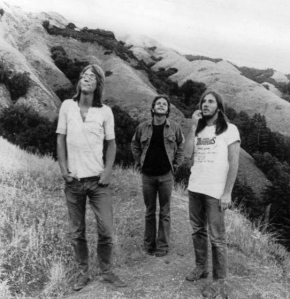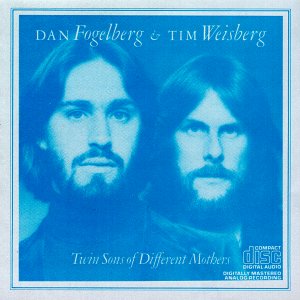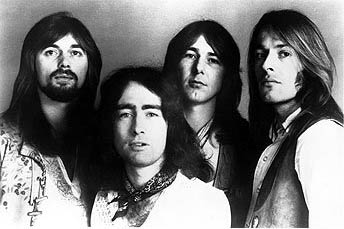(Note: If you’re looking for my Battle of the Bands post, well, you just passed the link but anytime you come here, you can find a list of my recent posts with links on my sidebar; or you can simply scroll down on the Home page until you reach it. Now back to our regularly scheduled programming…)
Today’s Monday’s Music Moves Me hop is a Freebie theme, meaning we can do anything we want with our music posts. I’m sure it won’t be any surprise that I’m continuing my KALEIDOSCOPE OF COLOR SONGS SERIES. Since I did Silver last week, today I’ll be highlighting the color GOLD.
Here is my playlist with my favorite songs with the color GOLD in the title. I’ve pulled together some cool info, backstories and fun facts about each of the songs. After that is an interesting bit on the meaning of the color Gold. Enjoy!
Sister Golden Hair by America – Remember the band America? Every time I hear a song by them, it takes me back to when I had just started college and was working part-time for Waldenbooks. It was a great job! I remember my starting pay was minimum wage which at the time was $2.65/hour (!) but Walden’s was a great company and we got regular raises. (It’s shocking to think that was the hourly wage back then in 1980 but that was 38 years ago! Good God, we sure as hell should be A LOT farther along with the minimum wage rates in this country! …but that’s a topic for another day).
Back to music: You know the music that is usually played in bookstores: it’s typical book-browsing music, background music. But the managers I worked for (Kevin & Sue) were extremely cool people and while the store’s album collection consisted primarily of classical and instrumental “elevator music”, they did have the America’s Greatest Hits album.
The album actually has two names: History, to keep with the group’s tradition of issuing albums with names beginning with the letter “H,” and America’s Greatest Hits, to indicate that it is a compilation of the group’s hits. Of course I’d always put on that album during every shift I worked, usually playing it a few times each shift. Those were some good days back then…good people, good times.
Anyway, about America: They were a rock band formed in England in 1970 by Dewey Bunnell, Dan Peek, and Gerry Beckley. The trio met as sons of US Air Force personnel stationed in London, where they began performing live.
America achieved significant popularity in the 1970s and was famous for the trio’s close vocal harmonies and light acoustic folk rock sound. The band released a string of hit albums and singles, many of which found airplay on pop/soft rock stations.
The band came together shortly after the members’ graduation from high school, and a record deal with Warner Bros. Records followed. Their debut 1971 album, America, included the transatlantic hits “A Horse with No Name” and “I Need You”; Homecoming (1972) included the single “Ventura Highway”; and Hat Trick (1973), a modest success on the charts which fared poorly in sales, included one minor hit song “Muskrat Love”. 1974’s Holiday featured the hits “Tin Man” and “Lonely People”; and 1975’s Hearts generated the number one single “Sister Golden Hair” alongside “Daisy Jane.” History: America’s Greatest Hits, a compilation of all of their charting hit singles to date, was released the same year and was certified multi-platinum in the United States and Australia. Peek left the group in 1977, and their commercial fortunes declined, despite a brief return to the top in 1982 with the single “You Can Do Magic”. The group continues to record material and tour with regularity. Their 2007 album Here & Now was a collaboration with a new generation of musicians who credited the band as an influence.
“Sister Golden Hair” is a song written by Gerry Beckley and recorded for their fifth album Hearts (1975). It was their second single to reach number one on the U.S. Billboard Hot 100, remaining in the top position for just one week. (America’s first single, “A Horse with No Name,” went to #1 in 1972).
“Sister Golden Hair” was another enigmatic track with lots of harmony. Written and sung by Beckley, he says that it was based on a composite of different girls. When asked if it was written to anyone, Beckley said: “No, this is all poetic license. With ‘Sister Golden Hair,’ as far as my folks were concerned, I was writing a song about my sister, and I couldn’t quite fathom it; they must not have listened to the lyrics.” Haha
In his Songfacts interview, Gerry Beckley remembered writing the song by starting with the first line:
Well I tried to make it Sunday, but I got so damn depressed
“I’d like to point out that you can have a #1 record with a line that enters that darkly,” he said. “That’s kind of my thing: I try to mix these emotions and I think ‘Sister’ was a great example. Pretty good message in there. John Lennon famously said, ‘We don’t know what these songs are about till people tell us.’ So all of our songs, including ‘Horse,’ are open to interpretation. But ‘Sister’ was a relationship song and there is a variety of elements. We always combine them as songwriters so that they’re not verbatim, word for word, for a particular circumstance. Poetic license we call it.”
Later he explained that he made a demo of this song before America recorded their fourth album, Holiday, but he was happy with the songs they chose for that album so “Sister Golden Hair” sat on the shelf for a year, making the cut for their next album, Hearts.
“I can’t really tell you if it was a lack of faith in the song or not, but it was interesting to see,” he said. “It shows you that songs can have a life of their own – they might just need the right time and circumstances to surface.”
FUN FACT: This song was used in a bloody scene in the 2001 episode of the HBO TV series The Sopranos, “Another Toothpick.” After a mobster kills two people, the song plays on his car radio as he drives off. When he has trouble breathing and can’t reach his inhaler, he crashes the car and dies, but the song keeps playing.
Here’s the clip of The Sopranos episode that features the “Sister Golden Hair” song. It’s the part of the story when Bobby Baccalieri, Sr. comes out of retirement to whack his godson Mustang Sally. WARNING: THIS VIDEO CLIP IS RATED TV-MA-L,V for language and violence.
The part with “Sister Golden Hair” playing starts at the 4:15 mark if you want to forego the blood and foul language. But hey, it wouldn’t be The Sopranos if there weren’t blood and cussing, right?
I’d say there was some golden retribution there, eh?
The Power of Gold by Dan Fogelberg – Dan Fogelberg (Daniel Grayling Fogelberg (August 13, 1951 – December 16, 2007) was an American musician, songwriter, composer, and multi-instrumentalist.
In 1972, Fogelberg released his debut album Home Free to lukewarm response, although it eventually reached platinum status. He performed as an opening act for Van Morrison. Fogelberg’s second effort was more successful – the 1974 Joe Walsh-produced album Souvenirs. The song “Part of the Plan” became Fogelberg’s first hit. After Souvenirs, he released a string of gold and platinum albums, including Captured Angel (1975) and Nether Lands (1977). His 1978 Twin Sons of Different Mothers was the first of two collaborations with jazz flautist Tim Weisberg, which found commercial success with songs such as “The Power of Gold”. The song was written by Dan Fogelberg.
The closing track of the album, “The Power of Gold,” was released as a single, reaching number 24 on the Billboard Hot 100 in 1978. (The record would be Weisberg’s lone chart hit as an artist).
I found a wonderful tribute article on the Performing Songwriter website called Remembering Dan Fogelberg by Lydia Hutchinson (August 13, 2013). The author admits to having a “deep, abiding and often embarrassing love for Dan Fogelberg and his music” and actually credits Fogelberg (and her desire to meet him) as being her inspiration for starting Performing Songwriter magazine in 1993. She did meet him and interviewed him in 1994. Here are excerpts from the interview pertaining to this song and its album:
Tell me about that Twin Sons of Different Mothers with Tim Weisberg.
That was a real quickie. I had called Tim in to work on Nether Lands on a track. We just hit it off and I really liked his stuff, and it would be interesting to see what we could come up with. So I just started thinking about writing without lyrics, which is something I love to do. I started composing all of these pieces and asked Tim if he was interested. And he listened and said, “let’s do it.” So it was about six months, start of finish.
That album did really well, didn’t it?
Yeah, that just blew the top off the whole thing. And I was embarrassed to even put it out, you know. I mean, I liked it but I just thought it would be torn to shreds and ignored. And so I said, “Irving, you hold it for a week, I’m going to Europe,” (laughs). “I don’t want to be around when it comes out.” And then I got these calls in Amsterdam saying I had a hit record with it.
And “The Power of Gold” was the single from that?
Yeah. That was one of the few things that I’ve written specifically for radio that worked. We had this whole thing of all this instrumental bossa nova and other stuff—a pretty eclectic mix of music—and we had this big huge grandiose symphonic piece that I had written and actually tried to record. And I went home thinking that that wasn’t what we needed to end that album with. We needed something that rocked. And we had already done most of the album. So I remember just going home and banging this thing out in a day or two and calling Tim and saying let’s cut this other track. And we did it, threw it on there, and the next thing you know it was on the radio.
This song is about greed taking a person over without that person being aware of it. At one point, the singer asks a friend if he or she is “under the power of gold,” because “the face you’re wearing is different now,” and to “balance the cost of the soul you lost, with the dreams you lightly sold.”
Dan Fogelberg, at the age of 56, died on December 16, 2007 from prostate cancer. In tribute to Fogelberg, his hometown of Peoria, Illinois renamed Abington Street in the city’s East Bluff neighborhood “Fogelberg Parkway”. The street runs along the northeast side of Woodruff High School, Fogelberg’s alma mater, and where his father was a teacher and bandleader. Fogelberg Parkway continues northwest, then west, to the intersection of N. Prospect and E. Frye, the location of the convenience store where Fogelberg ran into his old high school sweetheart one Christmas Eve – as described in the song “Same Old Lang Syne”.
The Dan Fogelberg Memorial is located in Riverfront Park in Peoria. A Memorial Committee was formed to initiate funding, design and installation. The project was privately funded by Dan’s friends, colleagues and fans and officially dedicated August 28, 2010. The Dan Fogelberg Memorial was honored yearly by fans during the Fogelberg Foundation of Peoria’s ‘Dan Fogelberg Celebration Weekend’ from 2011-2015, where a blessing and song of Dan’s are performed prior to the Saturday afternoon picnic next to the site. The landscaping is lovingly cared for and enhanced so that it remains a beautiful tribute all year round. This tribute memorial is enjoyed by the citizens of Peoria and visiting fans from across the country. (I was curious as to why the celebration weekends seemed to end in 2015 so I found on a Facebook page some comments that alluded to the city wanting to build apartments on that site so I’m not sure whether the DF Memorial is actually still there. I’ll look it up when I have more time…). In the meantime, here’s a slideshow of the Dan Fogelberg Memorial:
Gold Dust Woman by Fleetwood Mac – “Gold Dust Woman” is a song from the best-selling Fleetwood Mac album Rumours. It was written and sung by Stevie Nicks and released as a B-side to the “Don’t Stop” single (in the UK) and the “You Make Loving Fun” single (in the US).
The take chosen for release on the 1977 Rumours album was reportedly recorded at 4 a.m., after a long night of attempts in the studio. Just before and during that final take, Stevie Nicks had wrapped her head (though not mouth) with a black scarf, veiling her senses and tapping genuine memories and emotions. Many unusual instruments were used in the recording, including an electric harpsichord with a jet phaser, which was marked with tape so Mick Fleetwood could play the right notes. To accentuate Stevie’s vocals, Mick broke sheets of glass. “He was wearing goggles and coveralls — it was pretty funny. He just went mad, bashing glass with this big hammer. He tried to do it on cue, but it was difficult. Eventually, we said, ‘Just break the glass,’ and we fit it all in.”
In Mick Fleetwood’s book My Life and Adventures in Fleetwood Mac, he explains that it took Nicks eight takes to get the vocal right, and they were recorded early in the morning. Fleetwood described Nicks as “hunched over in a chair, alternately choosing from her supply of tissues, a Vicks inhaler, a box of lozenges for her sore throat and a bottle of mineral water.”
Cris Morris, who was a recording assistant on the sessions, explained in Q magazine: “Recording ‘Gold Dust Woman’ was one of the great moments because Stevie was very passionate about getting that vocal right. It seemed like it was directed straight at Lindsey and she was letting it all out. She worked right through the night on it, and finally did it after loads of takes. The wailing, the animal sounds and the breaking glass were all added later. Five or six months into it, once John had got his parts down, Lindsey spent weeks in the studio adding guitar parts, and that’s what really gave the album its texture.”
Slant critic Barry Walsh described the song as finding Nicks “at her folky (not flaky) best with one of her most poignant character studies”.
The lyrics allude to cocaine, which the band was consuming in quantity during the Rumours sessions. The line, “Take your silver spoon, dig your grave,” can clearly be seen as a reference to a coke spoon.
When asked about the song in an interview with Courtney Love for Spin in October 1997, Nicks confirmed that “gold dust” was a metaphor for cocaine.
“Everybody was doing a little bit–you know, we never bought it or anything, it was just around–and I think I had a real serious flask of what this stuff could be, of what it could do to you…And I really imagined that it could overtake everything, never thinking a million years that it would overtake me. I must have met a couple of people that I thought did too much coke and I must have been impressed by that. Because I made it into a whole story.”
Nicks’ relationship with Fleetwood Mac guitarist Lindsey Buckingham may also have influenced the song, as they had broken up and were going through some very difficult times, using songs as a medium for expressing their feelings to each other.
In an interview for VH1’s Classic Album series, Nicks offered further insight into the song’s meaning:
“”Gold Dust Woman” was my kind of symbolic look at somebody going through a bad relationship, doing a lot of drugs, and trying to make it. Trying to live. Trying to get through it.”
On Fleetwood Mac’s 2014-2015 tour, they did an extended version of this song that often stretched past 10 minutes, with Stevie Nicks losing herself in the music during the long instrumental break. She would often feel the effects the next day, as the dancing took a toll on her back. Speaking with Rolling Stone, she explained: “It’s the drug addict in ‘Gold Dust Woman’ who is breaking her back. She’s out there looking for drugs, and I’m trying to create that situation onstage so people get what it’s about, which was a very heavy, bad time in my life.”
I found a very interesting video on YouTube, edited and produced by Munrow’s Retro and I was intrigued by his interpretation of the lyrics, which is depicted through his video. I’ve included his video in my playlist so be sure to give it a view and read his interpretation here:
“The premise was originally about cocaine use and the fear of where it might lead to. Stevie Nicks told Courtney Love in a 1997 interview: “You know what, Courtney? I don’t really know what ‘Gold Dust Woman’ is about. I know there was cocaine there and that I fancied it gold dust, somehow. I’m going to have to go back to my journals and see if I can pull something out about ‘Gold Dust Woman’. Because I don’t really know. It’s weird that I’m not quite sure. It can’t be all about cocaine.”
I would suggest that in the end it had almost NOTHING to do with cocaine, although maybe it did in the first draft of the lyrics. In any event, somehow tumultuous and personal romantic relationships got into the mix and a whole lot of real pain. This I believe was the actual working model and that the “cocaine” as a sort of “gold dust” became a more incidental starting point part of the story. Unraveling the actual “story” will probably never happen as this appears to be fragments of feelings and experiences and real personal fears of the future (Nicks’ future) pulled together to form a whole.
Ultimately, the listener can make whatever story out of this song they want to or think they hear in it. The ending is very ominous and quite hopeless as the lyrics attest.
The “Gold dust woman,” I believe in this case, is a woman of privilege and eventually power, born with a “silver spoon” in her mouth, who nevertheless manages to “dig her grave” with it. Her wealth and high position bring her only unhappiness and disappointment as she goes through an endless series of “lousy lovers.” Something painful happens, something very bad that is not to be found in the lyrics. That part you can make up as you see fit. It leads to the woman ultimately being reduced to a “pale shadow” of her former self, and then becoming a “woman of dust.” Thus, she returns to the dust … and dust in this context means Death. In her case, in a twist of macabre irony, the dust this wealthy woman returns to is gold. But whether the dust is gold or grey, the ending is the same for all: “ashes to ashes, dust to dust.” In the end this is a frightening, eerie folk ballad based partly on fact and partly on fiction. “
So what have your interpretation of this song’s lyrics been?
In addition to the creative video that goes along with the above interpretation I’ve also included the live performance of “Gold Dust Woman” during the concert that was recorded for Fleetwood Mac’s MTV The Dance special at Warner Brothers Studios in Burbank, California on May 23, 1997.
The Dance is the live album that hailed the return of the band’s most successful line-up of Lindsey Buckingham, Mick Fleetwood, Christine McVie, John McVie and Stevie Nicks, who had not released an album together since 1987’s Tango in the Night a decade earlier.
This was the last Fleetwood Mac album to feature Christine McVie, who left the group a year after the album’s release. Debuting at No. 1 on the Billboard 200 with sales of 199,000, The Dance became the fifth best-selling live album of all time in the United States, selling a million copies within eight weeks, spending more than seven months within the top 40, and eventually selling over 6,000,000 copies worldwide. The DVD version has been certified 9x platinum in Australia for selling 135,000 copies. The 44-date tour grossed $36 million.
Fields of Gold by Sting – “Fields of Gold” is a song written and recorded by Sting. It first appeared on his 1993 album Ten Summoner’s Tales. The song was released as a single but only made it to number 16 on the UK Singles Chart and to number 23 in the United States Billboard Hot 100. But it became one of Sting’s most famous songs, with many renowned artists covering the song.
“Fields of Gold” and all the other album tracks were recorded at Lake House, Wiltshire and mixed at The Townhouse Studio, London, England. The harmonica solo is played by Brendan Power, and the Northumbrian smallpipes are played by Kathryn Tickell. Sting started writing this on the guitar. He thinks his simple songs are often his best, and uses this as an example.
This song is about feeling joyous, but knowing that the joy is going to end someday. Sting wrote it after he bought a house near a barley field. The sunsets and the colors of the field were an inspiration for the lyrics, along with his love at the time, Trudie Styler, who he married in 1992. Styler has said that the song is one of her favorites.
The major theme in this song is commitment. It is about a man who has broken promises before, but is determined make this relationship last.
The story is chronological. It is about courtship, marriage, and eventual death. The two people in the song meet, court, fall in love (at this point, he reveals that he has never really made such a strong promise/commitment to someone) but feels he is ready to now. “See the children run,” their offspring and the “jealous sky” refer to the Heavens. Even Heaven is jealous of their love/relationship. The esteemed sun is jealous. Eventually, he dies and tells his love that they will always remember their love specifically, when she thinks of him, he wants to be personified as such… walking in fields of gold (barley).
In Lyrics by Sting, the singer described the view from his 16th-century Wiltshire manor house:
“In England, our house is surrounded by barley fields, and in the summer it’s fascinating to watch the wind moving over the shimmering surface, like waves on an ocean of gold. There’s something inherently sexy about the sight, something primal, as if the wind were making love to the barley. Lovers have made promises here, I’m sure, their bonds strengthened by the comforting cycle of the seasons.”
I’m sitting here listening to the song as I’m reading some background on it and the music is penetrating my very being; I find myself moving, slowly, rhythmically back and forth, surrendering to the music…and then I come across this little Sting tidbit:
‘Audiences have taken to swaying like the barley fields in the breeze when Sting performs this, which annoys the singer to no end. He told Mojo in 1995: “It’s disconcerting. But you can’t stop them, can you? Oi! Stop that fucking shite!”’
Eh, c’mon Sting, dial it back Dude, and just be happy that your music makes people sway and swoon… Geez!
The music video, directed by Kevin Godley, is included in the playlist and features a silhouette of Sting walking through a village containing common features seen throughout the UK such as a red telephone box and a red pillar box.
Golden Years by David Bowie – “Golden Years” is a song written and recorded by David Bowie in 1975. It was originally released in a shortened form as a single in November 1975, and in its full-length version in January the following year on the Station to Station album. It was the first track completed during the Station to Station sessions, a period when Bowie’s cocaine addiction was at its peak. At one stage it was slated to be the album’s title track. As of January 2017, the single had sold over 2.6 million units worldwide.
There’s a great article in the January 23 2017 issue of Rolling Stone magazine that explores the making of the album. Read how David Bowie’s dark, cocaine-fueled L.A. lifestyle inspired his 1976 masterpiece ‘Station to Station’.
Bowie was looking to emulate something of the glitzy nostalgia of “On Broadway”, which he was playing on piano in the studio when he came up with “Golden Years”.
Bowie’s ex-wife Angela claims this was written for her. Bowie does appear to be addressing someone specific in this song, encouraging them to revel in their “golden years”: “Don’t let me hear you say life’s taking you nowhere, angel, come get up my baby, look at that sky, life’s begun, nights are warm and the days are young.”
But Ava Cherry also claims to be the inspiration for the song. Ava Cherry was a singer/model who spent four years as a back-up singer for David Bowie between 1974 and 1978, part of a trio along with Robin Clark and Luther Vandross. She was also a lover of Bowie’s during this period, and remained friends with the artist for years.
Bowie performed this song when he appeared on the American TV show Soul Train in 1975. He was one of the first white singers to appear on the show. Bowie reportedly got drunk beforehand to try and calm his nerves and the footage does appear to show him stumbling over his lyrics.
The resultant video clip was used to promote the single, and assisted Bowie’s continued commercial success in the United States, where it charted for 16 weeks and reached No. 10 in early-1976. It achieved No. 8 in the UK and No. 17 in Canada. The song was also a top ten hit in Ireland, the Netherlands and Sweden. As a digital download, it reached number four in the Hungarian singles chart in 2016. He does indeed kinda look a little drunk in this clip:
FUN FACT: Bowie wrote “Golden Years” with the intention of giving it to Elvis Presley, but he reportedly refused the song. Elvis died two years later.
After the Gold Rush by Neil Young – After The Goldrush is an acoustic album that led to many other confessional singer/songwriter works in the early ’70s (James Taylor, Carole King, etc.). Young had injured his back lifting a slab of polished walnut and standing up to play his electric guitar was impossible. In addition, he had dropped Crazy Horse as his backing band so he prepared an album of acoustic songs.
“After the Gold Rush” is a song written, composed, and performed by Neil Young and is the title song from the 1970 album of the same name. In addition to After the Gold Rush, it also appears on Decade, Greatest Hits, and Live Rust.
In his extensive biography on Mr. Young, author Jimmy McDonough reveals that After the Goldrush was an album loosely conceptualized around a screenplay of the same named written by child star, and Neil Young neighbor, Dean Stockwell. Apparently the only two songs on the album that are based on the as-yet-unproduced screenplay are this song and “Crippled Creek Ferry,” the closing song on the album.
The song consists of three verses, two of which describe dream visions involving Mother Nature. The three verses move forward in time from the past (a medieval celebration with the sun floating on the breeze), to the present (the singer lying, distressed, in bed with the full moon in his eyes when there is a nuclear bomb explosion i.e. sunburst), and, finally, the future (spaceships transporting the chosen ones to a new home in the sun). The theme of the sun links all three verses. On the original recording, in addition to Young’s vocals, two instruments are used in the song: a piano and a french horn. The french horn solo in the middle of the song is often replaced by a harmonica solo by Young in live performances. The line “Look at Mother Nature on the run / In the 1970s” has been amended by Young in concert over the decades and is currently sung as “Look at Mother Nature on the run / in the 21st century.”
FUN FACT: The song has been covered a variety of artists. When Dolly Parton, Emmylou Harris and Linda Ronstadt recorded it in 1999 for their collaboration Trio, they got some unique insight into the song from the man who wrote it. Said Parton:
“When we were doing the Trio album, I asked Linda and Emmy what it meant, and they didn’t know. So we called Neil Young, and he didn’t know. We asked him, flat out, what it meant, and he said, ‘Hell, I don’t know. I just wrote it. It just depends on what I was taking at the time. I guess every verse has something different I’d taken.'”
This wasn’t first time Parton recorded the song: she included a version with Alison Krauss on her 1996 album Treasures.
Heart of Gold by Neil Young – “Heart of Gold” is a song by Canadian singer-songwriter Neil Young. Released from the 1972 album Harvest, it is so far Young’s only U.S. No. 1 single. In Canada, it reached No. 1 on the RPM national singles chart for the first time on April 8, 1972, on which date Young held the top spot on both the singles and albums charts. Young became the first Canadian to have a #1 album in the US when Harvest topped the Billboard 200 for two weeks in April 1972. Billboard ranked it as the No. 17 song for 1972.
The song, which features backup vocals of James Taylor and Linda Ronstadt, is one of a series of soft acoustic pieces which were written partly as a result of a back injury. Unable to stand for long periods of time, Young could not play his electric guitar and so returned to his acoustic guitar, which he could play sitting down. He also played his harmonica during the three instrumental portions, including the introduction to the song.
This photo, taken in 1971, is Neil’s first time performing live his haunting folk ballad “Heart of Gold,” a song about searching for love in a world that is progressively becoming darker.
“Heart of Gold” was recorded during the initial sessions for Harvest on February 6–-8 1971 at Quadrafonic Sound Studios in Nashville, Tennessee. Ronstadt (who herself would later cover Young’s song “Love is a Rose”) and Taylor were in Nashville at the time for an appearance on Johnny Cash’s television program, and the album’s producer Elliot Mazer arranged for them to sing backup for Young in the studio.
James Taylor and Linda Ronstadt don’t come in until the end of the song and they came into the studio on Sunday, February 7, the day after the rest of the song was completed. When it was their turn to add harmonies, the task proved rather arduous. Ronstadt recalled to Mojo: “We were sat on the couch in the control room, but I had to get up on my knees to be on the same level as James because he’s so tall. Then we sang all night, the highest notes I could sing. It was so hard, but nobody minded. It was dawn when we walked out of the studio.”
By far, this was the biggest hit for Young as a solo artist. A very influential musician, he was never too concerned about making hit records. Young wrote in the liner notes of his 1977 compilation album Decade: “This song put me in the middle of the road. Traveling there soon became a bore so I headed for the ditch. A rougher ride but I saw more interesting people there.” This statement was in response to the mainstream popularity that he gained as a result of the number-one status of “Heart of Gold”. This statement reflected Young’s aversion to fame, and was not meant to demean the song. In a later interview with NME, he clarified: “I think Harvest is probably the finest record I’ve made.”
FUN FACT #1: This was the song that tweaked Bob Dylan; Young had made no secret that he idolized Dylan, but when Dylan heard “Heart of Gold” he thought this was going too far.
In 1985, Bob Dylan admitted that he disliked hearing this song, despite always liking Neil Young. As quoted in Neil Young: Long May You Run: The Illustrated History, Dylan complained,
“The only time it bothered me that someone sounded like me was when I was living in Phoenix, Arizona, in about ’72 and the big song at the time was “Heart of Gold”. I used to hate it when it came on the radio. I always liked Neil Young, but it bothered me every time I listened to “Heart of Gold.” I think it was up at number one for a long time, and I’d say, “Shit, that’s me. If it sounds like me, it should as well be me.””
FUN FACT #2: In 2005, “Heart of Gold” was named the third greatest Canadian song of all time on the CBC Radio One series 50 Tracks: The Canadian Version. It ranked behind only Barenaked Ladies’ “If I Had $1,000,000” and Ian and Sylvia’s “Four Strong Winds”, the latter covered by Young on his 1978 album Comes a Time.
FUN FACT #3: Lady Gaga references this in her song “You and I.” The line goes, “On my birthday you sung me ‘Heart of Gold,’ with a guitar humming and no clothes.”
Silver, Blue & Gold by Bad Company – The following blurb is a repeat as I included this song in last week’s Silver Edition post (and I’ll probably include it when I get to the Blue portion of my series…because it’s one of my favorite songs and because I can…) 😊
“Silver, Blue & Gold” is a song from Run with the Pack, the third studio album by the English supergroup Bad Company, written by Paul Rodgers. A fixture on rock radio for decades, Paul Rodgers has been the driving force behind countless rock ‘n’ roll classics. The bulk of his legacy, however, remains with Bad Company.
Co-founded in 1973 by Paul Rodgers, Mick Ralphs (Mott the Hoople guitarist), Simon Kirke (drummer) and the late Boz Burrell (former King Crimson bassist & vocalist), Bad Company grew out of Free, which also featured Rodgers and Kirke. Over the next nine years, they released four platinum or multi-platinum albums together before Rodgers departed for a lengthy hiatus. During that period, he could be found bending the ears of music fans worldwide with the Firm (with Jimmy Page), the Law (with Who drummer Kenney Jones) and later even toured with the members of Queen.
“Silver, Blue & Gold” was released in January 1976 on the wildly successful Run with The Pack album, which was the band’s third consecutive platinum seller. It was recorded in France with The Rolling Stones Mobile Truck in September 1975 with engineer Ron Nevison and mixed in Los Angeles by Eddie Kramer.
Upon its release, the album soared to No. 5 on the US Billboard 200 and peaked at No. 4 in the UK Albums Chart. With three albums now to their credit, the central ingredient to the group’s remarkable success was their steady stream of first rate original material. Rodgers and Ralphs were the group’s composers. “I always thought it was important for the group to have more than one writer,” states Rodgers.
Coupled with the strength of the group’s song writing was the clarity and unmistakable power of Rodgers’ voice. Rodgers moved with ease among a wide range of emotions and musical styles. Rodgers’ “Silver, Blue & Gold” celebrated the group’s skills for ballads, highlighting a softer, more introspective vocal performance by Rodgers.
Although “Silver, Blue & Gold” remains one of the band’s most popular compositions, the song was never released as a single. “Silver, Blue and Gold” is a fan favorite and it’s one of Bad Company’s very best songs, artfully charting the oft-experienced tale of a love gone wrong and the aftermath as the spurned party seeks solace in silver, blue and gold–and the rainbow that’s long overdue.
That’s it for my favorite Gold songs. What are your favorite Gold songs? Please share in the comment section below. To close, I’ll leave you with:
THE MEANING OF THE COLOR GOLD
Taken from the Bourn Creative’s Color Meaning Blog Series:
The color gold is the color of extravagance, wealth, riches, and excess, and shares several of the same attributes of the color yellow. The color gold is a warm color that can be either bright and cheerful or somber and traditional. The color gold is cousin to the color yellow and the color brown, and is also associated with illumination, love, compassion, courage, passion, magic, and wisdom.
Gold is a precious metal that is associated with wealth, grandeur, and prosperity, as well as sparkle, glitz, and glamour. Gold is the official fiftieth wedding anniversary gift, with copper as the official seventh wedding anniversary gift and bronze as the official eighth wedding anniversary gift.
Gold gemstones are believed to increase personal wisdom and power, aid in health and wellness, create success and prosperity, and illuminate the path toward your goal.
Other meanings associated with the color gold:
- The term “fool’s gold”refers to anything mistaken for gold, or something that is worthless.
- The phrase “gold star”is used to signify praise, accomplishment, and commendation.
- The saying “solid gold”refers to superior, high-quality, outstanding, and best of the best.
- The term “gold standard”is a measure of the best, quality, and excellence.
- The phrase “gold brick”is used in reference to a trick, cheat, or actions of deceit.
- The phrase “good as gold”means that something is valuable or positive.
- The expression “golden child”refers to a favored person.
- The expression “gold digger”describes someone who is only after a person’s money.
Additional words that represent different shades, tints, and values of the color gold: goldenrod, yellow gold, honey, bronze, copper.
Monday’s Music Moves Me (4M) is a blog hop hosted by X-Mas Dolly, and co-hosted by JAmerican Spice, Stacy Uncorked and Curious as a Cathy. Be sure to stop by the hosts and visit the other participants.
This is a Blog Hop!































Hi, Michele!
The readers struck gold with this post of yours featuring great rock songs with titles of gold. I am familiar with every artist presented, but most of the gold songs are new to me. The ones I do remember are America’s “Sister Golden Hair,” Bowie’s “Golden Years” and the two gold nuggets by Neil Young (Mrs. Shady’s favorite solo artist). I could listen to Stevie Nicks sing all day every day, and the witchy woman is at her best in live performances. It was interesting to read the back story about the creation and meaning of Stevie’s “Gold Dust Woman” which starts out as a song about (and metaphor for) cocaine and evolves, as does much of her work, into a highly personal opus elucidating her pain as the result of a bad love relationship. It was great to see that clip of Bowie on Soul Train, reminding us that he was one of the few white artists to appear on the series, his superstar contemporary Elton John being another.
Somewhere along the line I learned that the colors red and gold along with the achromatic colors black and white, are the four colors that are the most eye catching and evoke the most powerful emotional response in humans. That is why the four are widely used in advertising.
Thank you for a very entertaining post, dear friend Michele, and have a great week!
LikeLike
Michele,
You really put your heart and soul into these posts. I truly appreciate the effort, girl! This morning, I played your wonderful “Gold” playlist while I responded to commenters to yesterday A2Z Theme Reveal and while doing return visits.
The Sopranos was an awesome TV series. DH told me someone has a Sopranos movie in the works. I’m not sure if it’s a TV or big screen production. It’ll be interesting to see it once it releases but it’ll be a hard follow with James Gandolfini dead. I wonder if they’ll replace him with a new Tony Soprano or write him out of it or will Tony’s son step into his father’s shoes? There’s a whole lot of ways the writers can go with it.
Your song mix included some introductions but mostly reintroductions to tunes long forgotten, like “Silver, Blue, and Gold” by Bad Company. Thanks for boogieing with the 4M gang, my friend. Have a pawsome week! 😉
LikeLike
You chose some good songs for this list. I always liked “Goldfinger” by Shirley Bassey and “The Man With The Golden Gun” by Lulu, myself…
LikeLike
Way ta go sista! You had me with David Bowie’s dem golden years I use to play over & over! Awesome tune! hahaha Stevie Nicks has always been on of my dearest idols. What a career & life that woman has had. Oh my I could go on and on, but I must boogie on to our next dancer! Thanks for the dance my friend. It has truly been delightful and so happy, so very happy you have joined us. I also have to get at my nephew & future neice’s bed apron I am crocheting for her wedding shower. Oh & if you want to see anything else I’ve done check out my pinterest. I have a whole section there. Hope you like it! It’s in May and it’s a biggen… hahaha It will be beautiful though. Naturally I’ll show it off when it’s done! BIG HUGS AND LOVED LOVED LOVED the Soprano clip you added. We watched that faithfully being Sicilian decent my cousins had the telephone light buzzin the whole time that one was on. hahaha! BIG HUGS
LikeLike
What an amazing list and love all of your facts about them. Thanks for sharing.
LikeLike
There are a lot of memories for my life in this playlist. Good songs.
One of my favorite artists Bruce Cockburn had a song called “Sahara Gold”. \
LikeLike
Great choices. I had forgotten about that scene in The Sopranos, great show.
LikeLike
Those are all great songs and great artsts! Thanks for sharing.
LikeLike
SISTER GOLDEN HAIR is my all-time favorite song by America (followed very, very closely by ‘Tin Man’). It always reminds me of Inga, a woman with golden hair, whom I once knew.
(Can you imagine me being involved with a woman named Inga? That’s just wrong. An Amy, maybe. Or a Lisa. Or a Kathleen, or Yolanda. But an Inga? Nah. I’m just not an Inga-kind-of-guy. Although I guess I didn’t know that about myself once upon a time ago.)
It’s amusing about Bob Dylan and Neil Young. Especially when one considers that America’s ‘A Horse With No Name’ sounds even more like Neil Young than Neil Young sounds like Bob Dylan on ‘Heart Of Gold’.
That might make for an entertaining BOTB comment section discussion:
BATTLE OF THE IMPOSTORS:
‘A Horse With No Name’ by Neil Young
versus
‘Heart Of Gold’ by Bob Dylan
I wonder how many voters would catch the errors.
Yo, Michele, there’s still time to vote on my current BOTB. (Not much, however. Tick-Tock, time’s a-drainin’ out.)
~ D-FensDogG
STMcC Presents ‘Battle Of The Bands’
LikeLike
Michele
I just love all the detail that you put into your posts. I was once that ambitious, but I seem to be lacking in that department as of late. Too many distractions, I guess.
One could argue that this post is ‘Solid Gold’.
My favorite of the songs you’ve posted today would have to be Gold Dust Woman. It’s been in my playlist the past few days.
Not sure if I’m going to use the suggested theme this coming week. I think I had 3 posts in the past year with that theme, so it’s a little played out on my blog for now. Gotta keep the readers in mind, they are more important 🙂
Thanks for the chat on FB today. Glad that you are safe, but be cautious of packages. Get those taxes done!
~Mary
LikeLike
Talk about Memory Lane, you took me there! I used to have that America album, maybe I still do, and played it over and over again. I’m with you on the minimum wage debate. People have got to have something to live off of, and ironically, when we don’t give them what they need in wages, they get desperate and take what they need through an increased crime rate. The Power of Gold is another one I hadn’t heard in ages. I guess since we remember all of these songs, we must be heading into our golden years. 😦 Thanks for the memories.
LikeLike